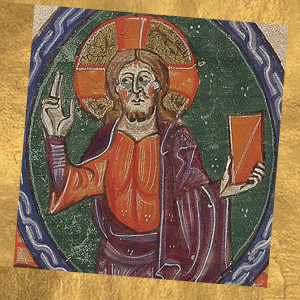St. Dominic of Guzmán, priest,Founder of the Order of The Preachers

For a Christian to live one’s life entirely consumed by Christ, to be united with Him in prayer, to have the Name of Jesus always on one’s lips, might seem an impossible ideal. And yet, we know of great men and women throughout history who have lived up to that ideal more or less closely. One of these was Dominic Guzman, St Dominic, an exact contemporary of St Francis, who, like the Poor Man of Assisi, tried to conform his life to the model of Jesus Christ.
The two preachers
Dominic’s story begins in 1170, with his birth in the small mountain village of Caleruega in Spain. Growing up in a pious family the young Dominic was steeped in the teachings of the Gospel. Perhaps inspired by the example of his uncle, who was a priest, a religious vocation seemed like a natural path for the young man. At age 24, Dominic was ordained, and soon became a Canon in the Cathedral of Osma. He was very close to the Bishop, Diego de Acebo, and at one point accompanied his Bishop on a diplomatic mission to Denmark. Returning from their mission by way of Rome, they asked permission to evangelize the northern pagans.
But closer to home, a dangerous heresy, known as Catharism or Albigensianism, had sprung up and was beginning to spread among the people in the region around the city of Toulouse. Recognizing their zeal for the Faith, the Pope of the time, Innocent III, sent them to preach, not among the distant heathens, but among the heretics of their own lands.
A man of encounter
Shortly after their return to France, Bishop Diego died, and Dominic was left alone to confront the growing heresy. He began the work of evangelization in earnest, meeting with Albigensians, preaching to them and exhorting them, debating with them privately and publicly. It was demanding work, but Dominic’s fervour never diminished.
Dominic was able to win a hearing from the heretics through the strength of his character, and because his life reflected his preaching. His affable manner, combined with a steely determination, gained him the respect of his adversaries. Years went by until, in 1215, a new opportunity arose.
Tender as a mother, strong as a diamond
That was the year of the Fourth Lateran Council, which was held in Rome. Dominic took part in the Council in the company of Fulk, the Bishop of Toulouse. During the Council, he approached the reigning Pontiff, Honorius with a project he had conceived many years earlier. On 22 December 1217, Pope Honorius approved a new religious order, the Order of Friars Preachers, or Dominicans.
The effect of the Pope’s decree was like an explosion. The newly founded Dominican Order spread rapidly, as the mendicant preachers proclaimed the Gospel throughout Europe and beyond with ardour and enthusiasm.
But for Dominic himself, life was drawing to a close. On 6 August 1221, only a few years after the papal approval of his Order, Dominic Guzman breathed his last in the Dominican convent in Bologna. Just thirteen years later, he was proclaimed a saint by Pope Gregory IX, who had known the great founder and preacher personally. Years later, St Dominic was described by one of his spiritual children as being “as tender as a mother, but as strong as a diamond.”







